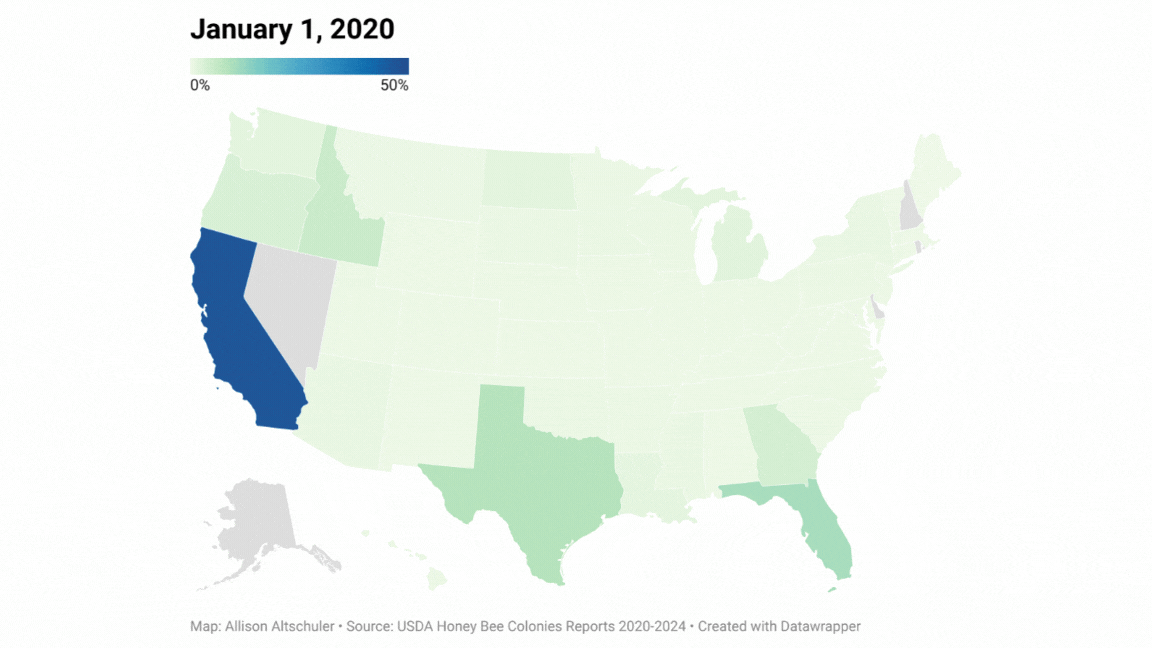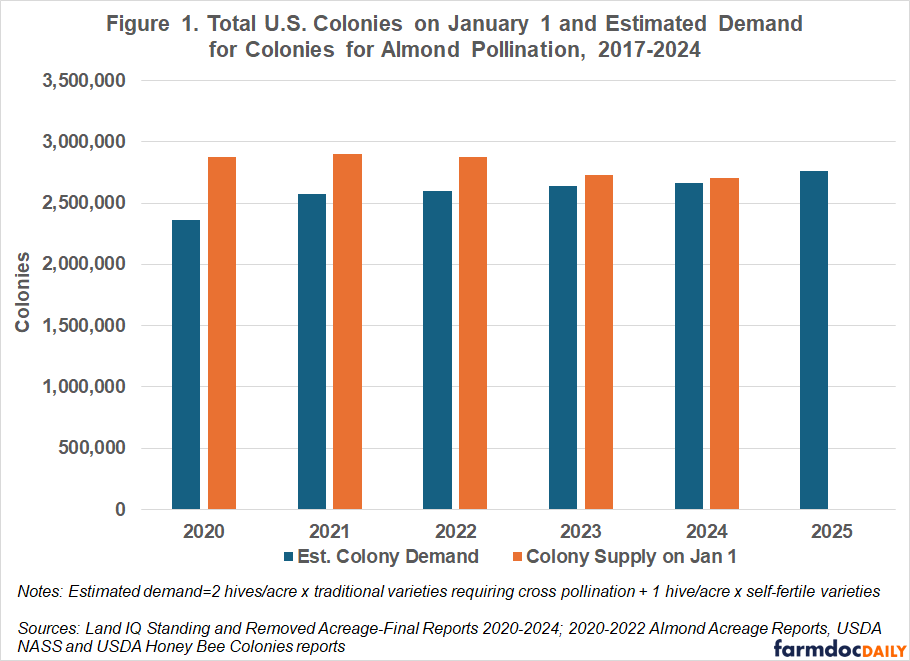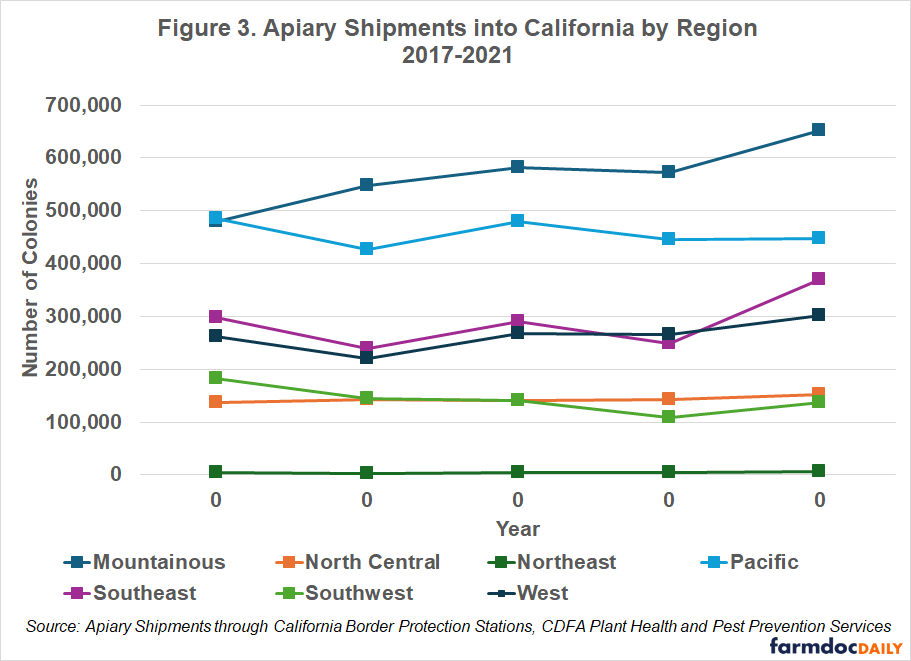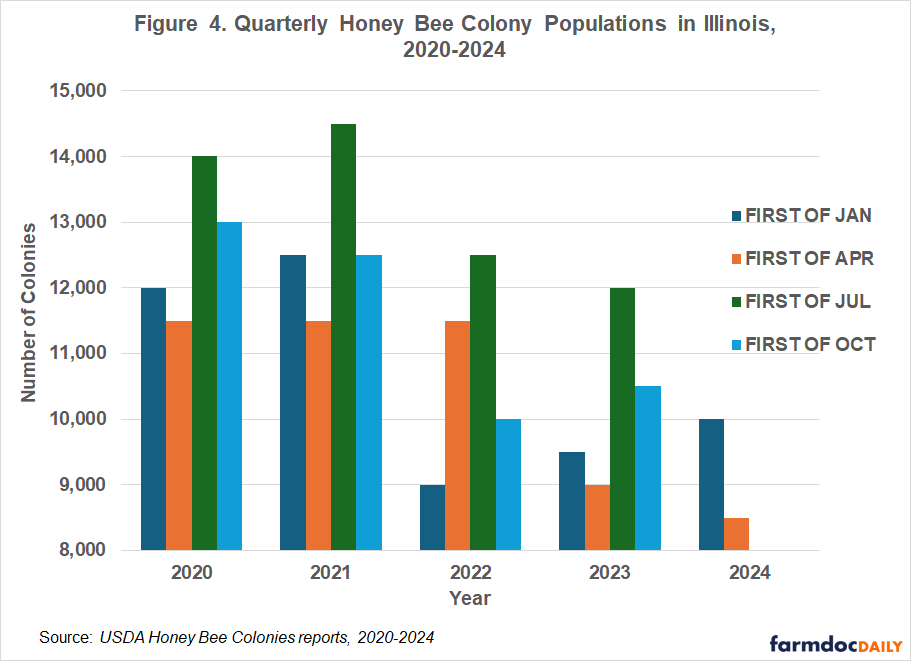Where Have All the Honey Bees Gone? To California Almond Orchards
Honey bees play a crucial role in the production of many fruit, tree nut and vegetable crops, yet their natural habitats often do not coincide with the locations of agricultural crops that require pollination services. This creates a significant need for movement of managed honey bee colonies, especially during critical pollination periods. While discussions about honey bee populations often focus on declines due to pests, diseases, or climate change, this article centers on the large-scale seasonal migration of colonies in the United States to meet pollination demands for the largest pollination event in the world, the California almond bloom. Many commercial beekeeping operations in the Midwest find it economically advantageous to send colonies to California almond orchards for pollination services, putting Midwest specialty crop producers in direct competition with California almond growers for necessary pollination services each spring.
The California Almond Pollination Market
Increasing almond production in California has led to the creation of the largest market for pollination services in the world—sometimes called “The Super Bowl of Beekeeping.” Honey bees play an essential role in almond production because most almond varieties require cross-pollination with pollen from a different variety. So, almond orchards are typically planted with multiple varieties of almond trees, and honey bee colonies are brought into orchards to facilitate the necessary cross-pollination. Each acre of almonds typically requires two honey bee colonies for adequate pollination, meaning California’s 1.4 million acres of almonds requires over 2 million honey bee colonies each year for pollination.
Figure 1 illustrates the estimated number of honey bee colonies needed for almond pollination from 2020 to 2025, alongside the total number of colonies available in the U.S. as of January 1 each year. This estimated demand is based on two colonies per acre for traditional almond varieties requiring cross-pollination and one colony per acre for self-fertile varieties. For the 2024 almond bloom, approximately 1.4 million acres of almond orchards required an estimated 2.7 million honey bee colonies for pollination, with 7.1% of these acres planted in self-fertile varieties that require fewer colonies per acre. As seen in Figure 1, the estimated demand for almond pollination in February of 2024 required virtually all (99%) of the colonies in the U.S. on January 1, 2024. In 2025, the estimated colony demand is expected to increase to 2.8 million colonies, a 3.5% rise from the previous year.
Where do all these honey bees come from? Honey bee colonies are not naturally concentrated in California almond-growing regions year-round due to inadequate food sources to sustain the roughly 2 million colonies during the remainder of the year. Thus, honey bee colonies must be transported into California in large numbers by commercial beekeeping operations located throughout the rest of the U.S. to meet the massive pollination demand.
Almond pollination occurs in mid-February, but preparation for this event begins months in advance. Beekeepers start planning for almond pollination as early as the late summer and fall of the previous year. This includes ensuring colonies are strong enough to meet pollination contract requirements, treating for pests and diseases such as Varroa mites, and supplementing bee nutrition with pollen substitutes and sugar syrup to sustain colony health during the winter. During December through February, colonies are transported to holding yards closer to orchards, where they undergo final inspections before being placed into almond orchards.
The primary economic driver behind this large-scale migration is the high pollination fees paid by almond growers, which currently average over $200 per colony. These fees must be high enough to cover transportation costs, labor, and colony preparation, as well as opportunity costs from foregoing income from honey production or other pollination services contracts (Goodrich, Williams and Goodhue, 2019). The almond bloom in February, which lasts for 3–4 weeks, provides beekeepers with more income than honey production throughout the remainder of the year, making it the single most important income stream for U.S. commercial beekeepers (Traynor, 2017).
The U.S. Beekeeping and Honey Bee Migration
Because commercial beekeeping operations are migratory, the USDA National Agricultural Statistics Service (NASS) keeps track of colony populations (and colony stressors) quarterly by state. These numbers are published annually in the Honey Bee Colonies report, which provides insights into the distribution of colonies across different states at different periods of time. The animation in Figure 2 illustrates the distribution of honey bee colonies throughout the U.S. across various quarters (January 1, April 1, July 1, and October 1) from 2020 to 2024.
Figure 2. The Distribution of Honey Bee Colonies by Percentage Across the United States
 Links to individual maps: Jan, Apr, Jul, Oct 2020; Jan, Apr, Jul, Oct 2021; Jan, Apr, Jul, Oct 2022; Jan, Apr, Jul, Oct 2023; Jan, Apr 2024
Links to individual maps: Jan, Apr, Jul, Oct 2020; Jan, Apr, Jul, Oct 2021; Jan, Apr, Jul, Oct 2022; Jan, Apr, Jul, Oct 2023; Jan, Apr 2024
As shown in Figure 2, most of the managed honey bee colonies in the U.S. are concentrated in California on January 1 each year due to the upcoming almond pollination season. For example, on January 1, 2024, 37% of all U.S. honey bee colonies were located in California, reflecting the industry’s reliance on the movement of colonies to meet almond pollination demands. Once pollination concludes, these colonies gradually disperse throughout the rest of the U.S., where they spend the remainder of the year producing honey and pollinating crops in different regions. The quarterly reports for April, July, and October reflect this dispersal pattern as colonies move away from California. For example, by July 1 each year the percentage of U.S. colonies located in California drops to around 20%.
Figure 3 illustrates honey bee colony migration from another perspective using data from apiary shipments into California by region from 2017 to 2021. Illinois is part of the North Central region, which consistently ships 140,000-150,000 colonies each year to California. In contrast, the Mountainous region with closer proximity to California (and therefore lower costs of shipment) consistently ships over 500,000 colonies. This large-scale migration highlights the critical intersection between beekeeping and agriculture, as well as the logistical and economic challenges associated with honey bee colony management.
Effects on Illinois Beekeeping Operations and Specialty Crop Producers
Figure 4 presents quarterly honey bee colony populations in Illinois from 2020 to 2024, revealing a seasonal pattern that reflects honey bee colony population dynamics and Illinois beekeepers participating in California almond pollination. Honey bee colony populations will generally be smaller during the winter months and into early spring while they are in a dormant overwintering state. Typically, colony losses occur over the winter and on average in recent years roughly 70% of colonies survived the winter (Giacobino and others, 2025). In the spring and summer months, colony populations will rapidly increase as food sources (nectar and pollen) become more available. During this time, beekeeping operations can “split” colonies and increase their colony numbers. This pattern is depicted in Figure 4, where Illinois colony populations are smallest during January and April, and largest in July. Notably, in all years except 2022, the colony populations in Illinois on January 1 were larger than those populations on April 1. This reflects a combination of colony losses during the late winter months and colonies leaving the state to go to California almonds between January 1 and April 1 that have not yet returned by April 1.
According to the 2022 USDA Agricultural Census, there are over 25,000 acres of specialty crops (apples, cherries, blueberries, cucumbers, squash, melons, pumpkins, and horseradish) in Illinois that depend on insect pollination services. Many of these specialty crop operations will pay a beekeeper to bring colonies to their fields for pollination services to ensure an economically viable yield. Thus, Illinois specialty crops growers, particularly of earlier blooming crops like apples and cherries, may find themselves competing directly with California almond growers for pollination services. This may mean having to pay higher pollination fees to incentivize beekeepers to keep colonies in the area to meet pollination needs. This is illustrated in the 2023 USDA Cost of Pollination report. Between 2017 and 2022, the number of colonies used for almond pollination increased by 27% (400,000 colonies). In 2017, the region that includes Illinois had pollination fees that averaged $74/colony and by 2022 that average had increased by 19% to $88/colony.
Summary
The large-scale migration of honey bee colonies is essential for meeting agricultural pollination demands, particularly in California’s almond industry. USDA reports from 2020 to 2024 highlight seasonal fluctuations in colony numbers, with bees relocating for pollination in winter and early spring, then dispersing throughout the U.S. by summer. As the U.S. demand for honey bee colonies continues to rise, pollination fees may need to increase to support beekeepers and maintain colony numbers. Understanding these migration patterns is crucial for ensuring the sustainability of both honey bee populations and the specialty crops that rely on their pollination services.
References and Data Sources
Bond, J. K., Hitaj, C., Smith, D., Hunt, K., Perez, A., and Ferreira, J. 2021. Honey Bees on the Move: From Pollination to Honey Production and Back, ERR-290, U.S. Department of Agriculture, Economic Research Service. https://www.ers.usda.gov/publications/pub-details?pubid=101475
Giacobino, G., Steinhauer, N., Brunner,S., Garcia-Andersen, N., Aurell, D., Rogers, S. and Williams, G. 2025. Preliminary Results from the 2023-2024 US Beekeeping Survey: Colony Loss and Management. https://apiaryinspectors.org/US-beekeeping-survey
Goodrich, B. K., Williams, J. C., and Goodhue, R. E. 2019. The great bee migration: Supply analysis of honey bee colony shipments into California for almond pollination services.
Goodrich, B. 2025. Economic outlook and other considerations for the 2025 almond pollination season. West Coast Nut. https://wcngg.com/2025/02/02/economic-outlook-and-other-considerations-for-the-2025-almond-pollination-season/
Traynor, J., 2017. A history of almond pollination in California. Bee World 94 (3), 69–79. https://www.tandfonline.com/doi/full/10.1080/0005772X.2017.1353273
US Department of Agriculture, National Agricultural Statistics Service. 2020-2024 Honey Bee Colonies Reports https://usda.library.cornell.edu/concern/publications/rn301137d?locale=en
US Department of Agriculture, National Agricultural Statistics Service. 2023 Cost of Pollination Report https://usda.library.cornell.edu/concern/publications/d504rk335?locale=en
Disclaimer: We request all readers, electronic media and others follow our citation guidelines when re-posting articles from farmdoc daily. Guidelines are available here. The farmdoc daily website falls under University of Illinois copyright and intellectual property rights. For a detailed statement, please see the University of Illinois Copyright Information and Policies here.










